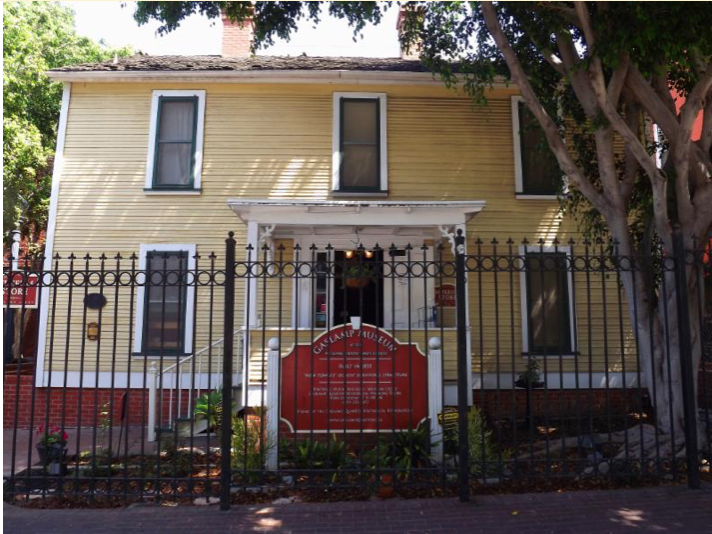No products in the cart.
Landmarks
The Many Homes of Alonzo Horton
When Alonzo Horton arrived in San Diego in 1867, he did what any newcomer would do – he looked for a place to live. Fortunately for Mr. Horton, there were three houses and the barracks left from William Heath Davis’s earlier attempt to establish a seaport in the area. Horton purchased one of the houses, then located at State St. and H (now Market St.) for $100.00, and that became the first humble abode of Mr. Horton and his wife, Sarah. It must also be noted that he purchased the house in her name, quite a cavalier gesture at the time! That house, the oldest structure in downtown or “New Town” San Diego, is now a museum and the home of the Gaslamp Quarter Historical Foundation.
The Davis-Horton House as it is now called, was built in 1850 in Portland, Maine. It was deconstructed and brought, along with 9 others, around Cape Horn on board the ship, Cybele. Its original destination was San Francisco where it was to serve as housing for the 49ers, but it arrived too late, and Davis seized the opportunity to purchase the ship and its cargo cheaply. His repurposed the houses as the foundation of his proposed new seaport town in San Diego. Unfortunately, Davis had a spell of bad luck, lost $700,000 in a warehouse fire, and his “new” town fell into abandoned disrepair. This sturdy little New England saltbox style house survived and is a historical landmark and tourist attraction. As for the Horton’s, they lived in the house until the first of their many mansions was built.
The first Horton mansion was located at 10th and G St., and as Alonzo put it, “the most ornamental house yet to be built in San Diego”. It was a one and a half story structure, heavily gabled and ornamented, with a covered front porch running the length of the front of the house. The property was planted with numerous ornamental trees, and was considered to be quite pretentious for the times. The home was called Cypress Cottage, and later became known as The Gables.
In March 1873, the Horton’s moved into their second mansion. Located at 6th and A St., it was a two-story frame structure with a magnificent view of the Coronado Islands, Point Loma and the bay. It was elegantly furnished, and had both gas lighting and water, which was supplied by the well at the Horton House Hotel. The mansion boasted a parlor and a library decorated with walnut framed tan furniture adorned with silk looped tops. The curtains were heavy lace, and Brussels carpets covered the floors in all the rooms. Additionally, there was a fine piano in the parlor. The ground floor also contained a kitchen, wash room, bathroom, two pantries and closets. The upstairs contained three bedrooms with closets!The Horton’s lived in this home, along with their niece, Amy Brown until 1874.
At this time, Horton built a new home on the northeast corner of First and Elm. This edifice was a replica of the house on Tenth and G. Horton was determined to push building north, and he felt that if he took the lead others would follow.
In 1885, Horton was able to achieve another of his dreams – he would finally build the hilltop mansion he had so long desired. Horton’s mansion at 1929 First St. between Fir and Grape contained 12 large rooms, some with fireplaces of black inlaid marble. The woodwork was of rare curly redwood. The landscaping was formal and very elaborate with many marble statues. The grounds were terraced leading down to the street with a retaining wall at the bottom. At the foot were two life sized gilded lion’s heads. The two-story building also featured a lookout and widow’s walk to enable Horton to view the ships that rounded Point Loma. He then ran up a flag to signal their imminent arrival and hurried down to the wharf to greet them. The cost of the house was approximately $18,000.00, but it had a million-dollar view. In 1891, President and Mrs. Benjamin Harrison visited Horton at this house.
In 1892, Horton moved yet again. This time to 2829 State St. to an 11 room house with an even more commanding view than the home on First Street. However, for a time, there was not much else in sight. This was the first and for a long time the only house on what came to be known as Horton’s Hill. The house had a veranda around three sides, a cupola and was crowned with a widow’s walk and lookout so that Horton could continue to look for arriving ships. To Horton, the view was everything.
Alonzo Horton or “Father Horton ” as he was called, passed away at Agnew Sanitarium on Beech and 6th Street on January 7, 1909. All his mansions have been razed, but the little New England salt box, his humble beginning, is still proudly standing at 410 Island Avenue.
Sandee Wilhoit is the Historian for the Gaslamp Quarter Historical Foundation. She can be reached at [email protected]

